Abstract
Nowadays the pollution is a stringent and critical problem that imposes serious measures to be taken into account. Water is one of the most important medium factors that facilitate the pollutants transport with serious consequences on the environment. There are many significant sources of water pollution which can affect the human health and may damage seriously the fauna and flora. The paper asserts the main sources of Danube’s pollution with heavy metals and proposes some solutions in decreasing the amount of these pollutant elements. The area of study that offered the data in this paper was the Somova – Parcheş aquatic complex, considered to be representative from the pollutant elements point of view. This area is located between Tulcea and Isaccea, in the pre-deltaic area of Danube Delta Biosphere reservation. Water is an medium factor, compulsory and crucial for everyday life, being the most outspread element on Earth. In nowadays situation, Terra finds itself in a critical period of its life from the pollution point of view and from the struggle for environmental protection point of view.
Keywords: Water pollutionheavy metalsDanube’s pollutionpollutant elementsenvironmental pollution
Introduction
In order to focus the Danube’s pollution with heavy metals, there are exposed the main sources
producing this negative effect.
Main sources of water pollution
Water is an medium factor, compulsory and crucial for everyday life, being the most outspread
element on Earth. In nowadays situation, Terra finds itself in a critical period of its life from the pollution point of view and from the struggle for environmental protection point of view. So, a major attention on
aquatic resources protection and on aquatic medium preservation is imposed.
The main sources of water pollution are exposed and classified according to two main criteria
exposed below in figure
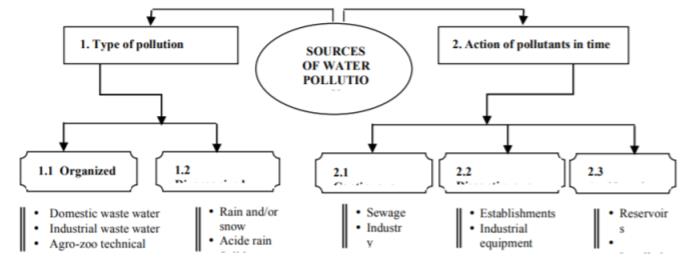
Presentation of the Danube’s ecosystem and its state
The Danube river ecosystem is crucially important for mankind because of the following elements:
water, fishing stock and the influence on the neighbouring ecosystems.
The Danube biotope and biocoenosis characteristics are exposed bellow.
a)Danube biotope characteristics:
�consolidated water course
�medium deepness 10 meters
�very puddle water
�a lot of sand and mud on the river bottom
�hydrological level depending on depth of rainfall
b)Danube biocoenosis characteristics:
�plants – rich phytoplankton
�invertebrates animals: developed zooplankton, snails, shells, crabs
�vertebrates animals: fish (carp, tench, bream, rudd, bass, catfish, luce) water snakes, birds
(Danube hawk)
Danube’s main sources of pollution
The Danube pollution can affect not only species of plants and fish, but also the potable water
used by the population in its hydro-graphic basin.
Waste waters evacuated in the most of the Romanian big cities across the river pollute massively
the Danube because there are not cleaning stations in those areas.
One of the most important pollutant cities is the capital because the waste water reaches
Dâmboviţa River that discharges in Argeş River and, after 20 km, in the Danube (Driga B.-V., 2006).
A report of Danube Delta Biosphere Administration (DDBA) shows that the traffic extension on
Danube River is leading to water pollution with petroleum products. This pollution takes place because of
unavailability of ships endowment with efficient petroleum remainder separators or, if these do exist, they
are not properly used.
Another problem is that Danube ports are not endowed with specific equipment for residuum
processing and recycling.
Negative effects of water pollution
The main phenomenon caused by heavy metal on environment, living organisms and human
health is both their tendency to accumulate in diverse type of tissues (vegetal, animal or human), and their
toxicity- even in small concentrations.
Over 90% of Cadmium (Cd), Plumb (Pb), Manganese (Mn), Nickel (Ni) and Zinc (Zn) found in
soft water and sediments is coming from human activities that, associated with suspended particles,
accumulates in sediments.
Land sources generating heavy metals are mainly the following: waste waters cleaning equipment,
industries, mining and agriculture.
Metals are transported either dissolved in water or as a whole part of sediments. Once arrived in
aquatic medium, main consequence is that they can be: dissolved in the water gauge, stored in sediments,
volatilised in the atmosphere, absorbed by organisms.
Important effects of water pollution with heavy metals: human and animal health affection; water
source damaging; appropriate alimentation assurance; environmental health affection.
Paper Theoretical Foundation and Related Literature
Mankind have polluted the environment with heavy metals since the prehistoric times, fact shown
in a study published last year in the Nature–Scientific Reports magazine. Along with the Industrial
Revolution, water pollution became more aggressive, factories realising more and more pollutant
elements into rivers and streams. Some examples in this direction:
CNN highlighted that “up to 500 millions tones of heavy metals, toxic sludge and solvents slip into the global water supply every year” (2007)
Greenpeace: 70% of China’s lakes and rivers are polluted from industrial residues
UNESCO: 70% of industrial waste are released untreated into the surface waters
Surveying carried on Danubein the control points Crişan, Mila 23, Caraorman, Pardina, Sontea
marked the exceeding of indicators: CCO-Cr (Chemical Consumption of Oxigen), phenols, phosphorus,
zinc. The exceeding shows an enhancement of organic and inorganic substances in the Danube water due to its filling from up-river (Jecu, E., Legendi,A., 2015).
The Somova – Parcheş aquatic complex, located between Tulcea and Isaccea, in the pre-deltaic
area of Danube Delta Biosphere reservation, is surrounded by lakes (Rotundu, Telnicea, Parcheş, Somova), Danube and vegetation (reed, reed mace and sallow). Two selected lakes of this complex - Somova and Rotundu - were considered to be representative due.
Six metals were monitored in the samples of water, sediments and two species of plants (reed, reed mace), namely Cd, Cr, Mn, Ni, Pb and Zn.
Observations were carried out three times a year, each lake apart and in the same station during 2007-2014. The average values from samples–water, sediments, macrophytes- were considered.
Authors’ Contribution on the Existing Theory and Practice in Educational Field
The authors’ practical contributions in educational field are the connected issues given and studied
at UTCB-DPPD within Technological education, the scientific communications, such as:
- The polluting sources impact on Tulcea environment. Thesis (UTCB-DPPD), 2015;
- The pollution of Danube’s water in Tulcea area. Scientific communication presented on
International interdisciplinary symposium ,,Technological Education-education for life”, Domain:
ecology and environment protection, 2015
- Polluting elements and reduction measures in Danube’s water. Scientific communication at
SINUC 2010, the XVI-th National Symposium for Technological Equipment in Constructions,
16-17 December, ISBN-978-973-100-144-9
Authors’ Contribution on the Topic
Information is based on samples collected in student practice and analysed in laboratory. The data processing and presentation in the diagrams plotted are original. Analysing the data collected, it was established:
The evaluation of heavy metals content in the Danube’s water (blue bars represent values from Rotundu lake, those bricky from Somova; blue and red lines show the trend of the respective diagram)
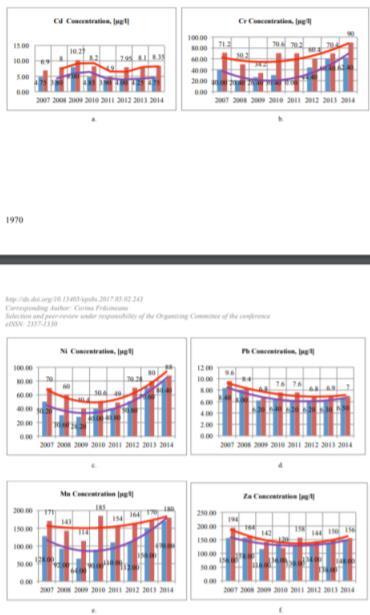
The evaluation of heavy metals content in the Danube’s sediments (blue bars represent values from Rotundu lake, those bricky from Somova; blue and red lines show the trend of the respective diagram)
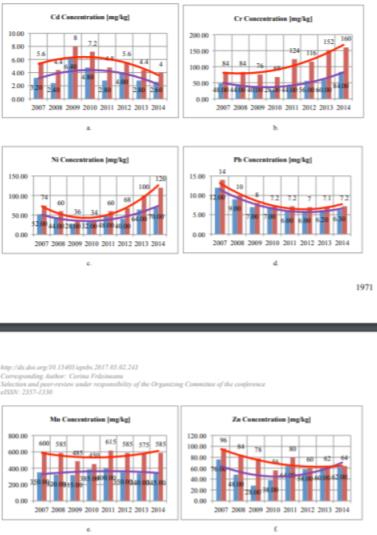
The concentrations of all the six heavy metals analyzed in the Danube’s sediments (figure
The evaluation of heavy metals content in the Danube’s aquatic vegetation
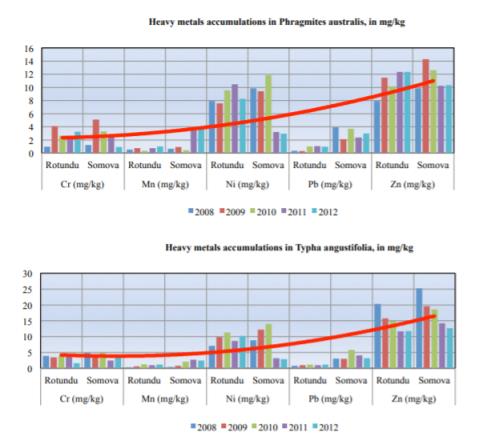
Diagrams in figure
Future evolution of the Danube’s pollution estimation
A descendent tendency of Cd, Pb and Zn concentration can be noticed (figure
waste water regulated discharge in emissary (waste water cleaning equipment). The rest of elements are
following a growing tendency estimated about 8…15 µg/l a year as the graphs’ values are showing.
The concentrations of heavy metals analyzed in sediments are increasing gradually (figure
marked as: Cd <Pb <Ni <Cr <Zn <Mn. A descendent tendency of Cd, Pb and Zn concentration is
remarked.The rest of elements are following a growing tendency estimated about 5…60 mg/kg a year.
Following the samples in situ and graphs plotted in figure
accumulation in aquatic vegetation is to be remarked, as: Mn<Pb<Cr<Ni<Zn.
Romania pollutes the most Danube’s waters. Germany and Austria, that possess both a shorter part
of Danube, are polluting together as much as Romania.
and their potential in exploitation as construction materials and biological filters for ecosystems.
Conclusions
Potential elements in the Danube’s pollution reduction
�Big factories in industry must adapt a permanent automation system in monitoring the quality of
escaped waters and the impact of waters’ quality escaped in the Danube that is to be verified by
the institutions empowered (National Agency of Environmental Protection, Romanian Waters)
�Cleaning equipment for waste waters in big and medium cities across the country
�Limitation in polluting the water courses by implementing the 91/271/CEEDirective
�Proper management of mud coming from waste water cleaning stations �Using the lab discoveries regarding the bioaccumulation attribute of some superior plants
Actions in the Danube’s pollution reduction
The main actions in heavy metals accumulation reduction are esteemed to be (figure
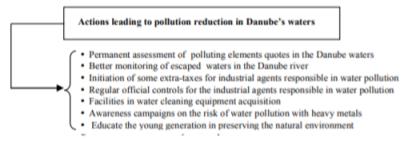
Strengths of analyse done by the authors in the paper
The main strengths of the analyse presented in the paper are the following:
-The main sources of Danube’s pollution with heavy metals are established
-Based on analyse done in laboratory, some diagrams were plotted regarding the evaluation of heavy
metals content in the Danube’s water, sediments and aquatic vegetation (figures
-Based on the values’ evolution in diagrams, the annual concentration trend is estimated in each case
previously mentioned
-The data processing and presentation in the diagrams plotted are original
-The paper proposes some solutions in decreasing the amount of heavy metals in Danube’s water,
sediments and aquatic vegetation
References
- Driga B.-V. (2006). Delta Dunării Sistemul circulaţiei apei.Academia Română, Institutul de Geografie, Casa Cărţii de Ştiinţă, Cluj-Napoca
- Jecu, E., Legendi, A.- coordonare ştiinţifică (2015). The polluting sources impact on Tulcea environment. Thesis. UTCB; 2-3, 36-42.
- Jecu, E., Legendi, A. (2015).The pollution of Danube’s water in Tulcea area. Scientific communication presented on International interdisciplinary symposium ,,Technological Education-education for life”,Domain:Ecology and environment protection
- Legendi, A.. (2010). Polluting elements and reduction measures in Danube’s water. Scientific communication at the XVI-th National Symposium for Technological Equipment in Constructions (SINUC), Section: Technological Education, ISBN-978-973-100-144-9
Copyright information

This work is licensed under a Creative Commons Attribution-NonCommercial-NoDerivatives 4.0 International License.
About this article
Publication Date
25 May 2017
Article Doi
eBook ISBN
978-1-80296-022-8
Publisher
Future Academy
Volume
23
Print ISBN (optional)
-
Edition Number
1st Edition
Pages
1-2032
Subjects
Educational strategies, educational policy, organization of education, management of education, teacher, teacher training
Cite this article as:
Legendi, A., & Frăsineanu, C. (2017). The Environmental Impact of Danube’s Pollution with Heavy Metals. In E. Soare, & C. Langa (Eds.), Education Facing Contemporary World Issues, vol 23. European Proceedings of Social and Behavioural Sciences (pp. 1967-1974). Future Academy. https://doi.org/10.15405/epsbs.2017.05.02.243

